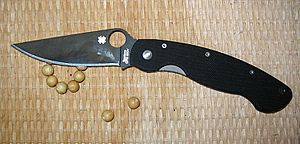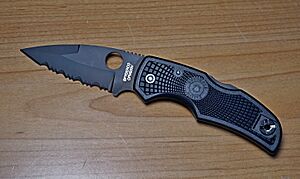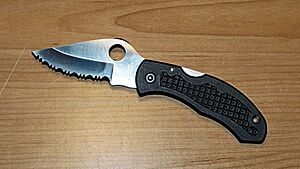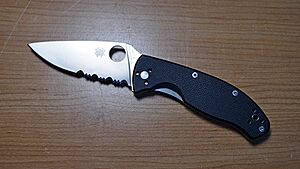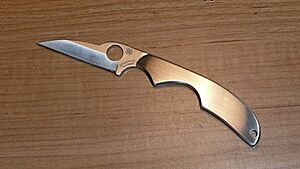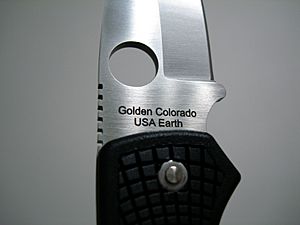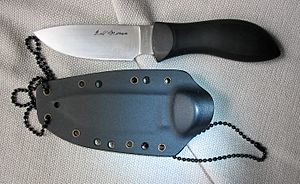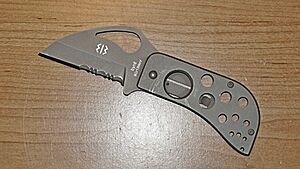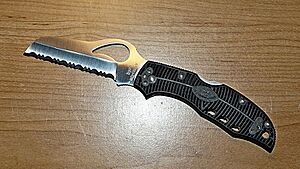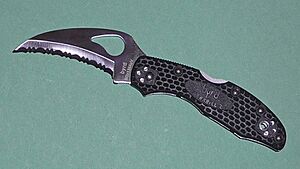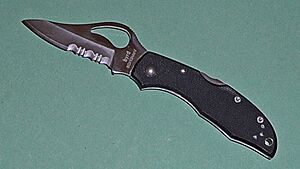Spyderco facts for kids
 |
|
| Proprietorship | |
| Industry | Manufacturing |
| Founded | Golden, Colorado 1978 |
| Headquarters | Golden, Colorado |
|
Key people
|
Sal Glesser, Founder & President |
| Products | Knives |
| Revenue | US$10 million |
|
Number of employees
|
84 |
Spyderco is an American company located in Golden, Colorado. They are famous for making high-quality knives and tools to sharpen them. Spyderco was a leader in creating many features now common on folding knives. These include the handy pocket clip, serrated (saw-like) edges, and a special round hole for easy opening.
The company has worked with many talented knife makers, athletes, and self-defense experts. Together, they have designed unique knives. Spyderco has also explored using over 20 different types of materials for their knife blades.
Contents
The Story of Spyderco
Spyderco was started by Sal Glesser. He chose the name "Spyderco" because many fast sports cars had "Spyder" in their names. He wanted his company's cutting tools to be known for high performance, just like those cars.
The very first product from Spyderco in 1976 was called the "Portable Hand." This spider-shaped tool had angles, ball joints, and clips. It helped people like jewelers and hobbyists work with tiny parts.
Sal Glesser and his wife, Gail, started small. They even used an old bread delivery truck as their home and traveled to shows. As their business grew, they moved to a bigger truck and trailer. They finally settled in Golden, Colorado, in November 1978.
In 1978, Spyderco began making knife sharpeners. Their first folding knife, the C01 Worker, came out in 1981. This knife was special because it had a round hole in the blade. This hole made it easy to open the knife quickly with one hand, whether you were right-handed or left-handed. This round hole is now a famous trademark for the company. Spyderco also says this knife was the first to have a pocket clip on the right side of the handle.
Spyderco Knives and More
Most knives made by Spyderco are folding knives. They come in many designs, using different blade materials, handle materials, and ways to lock the blade open. Spyderco also makes fixed-blade knives, which means the blade does not fold.
Spyderco knives can have a plain, smooth edge, a partially serrated edge, or a fully serrated "Spyder Edge." The most common materials for their handles are FRN (Fiberglass Reinforced Nylon) and G10. They also make knives with steel handles. Sometimes, for special limited editions, they use other unique materials for the handles.
A lot of Spyderco's knives are made by other companies in countries like Japan, Taiwan, Italy, and China. However, many of their most popular and important knives are still made right in the USA. Knives made with CPM S30V steel used to be made only in Golden, Colorado. But now, Spyderco also sends this steel to Taiwan to make some of their top-tier knives there.
Spyderco knives are popular with many different groups of people. This includes everyday citizens, firefighters, rescue workers, and police officers.
In 2000, Sal Glesser, the president of Spyderco, was honored. He was added to the Blade magazine Cutlery Hall of Fame. This was because of his big influence on tactical knife design, especially for the pocket clip, serrations, and the opening hole. He also worked with many custom knife makers.
Blade Materials
Spyderco is known for trying out new and different materials for their knife blades. For example, in 1994, they were the first company to use a special process called powder metallurgy in a knife made for sale. They were also the first knife company to use H-1 steel in a folding knife. They even have a "Mule Team Project" where people can test fixed-blade knives made from various steels.
Here are some of the blade materials Spyderco has used over the years:
- 154CM: A strong American stainless steel used for cutlery.
- 8Cr13MoV: A Chinese stainless steel often used in knives like the Tenacious and Byrd lines. It's known for being easy to sharpen.
- 440C: A stainless steel known for not rusting easily and being simple to sharpen.
- Aogami Super Blue: A high-quality Japanese steel. The "Blue" refers to the color of the paper it's wrapped in, not the steel itself.
- AUS-8: A common Japanese steel that can get a very sharp edge. It's easy to sharpen and resists rust fairly well.
- BG-42: A high-performance stainless steel.
- CPM S30V steel: An American steel made using powder metallurgy, designed especially for knives.
- CPM-M4: A very tough and wear-resistant steel, but it's not stainless.
- CPM-S90V: A super wear-resistant steel known for holding an edge for a very long time.
- CTS-XHP: A stainless steel often compared to D2.
- D2: A high-performance tool steel that resists wear well.
- GIN-1: A Japanese stainless steel that is tough and resists corrosion.
- H-1: A unique steel perfect for use near water, like in marine environments. It's completely rust-proof in normal conditions because it uses nitrogen instead of carbon.
- N690CO: An Austrian stainless steel similar to VG-10.
- VG-10: A Japanese steel known for getting a fine edge and being easy to sharpen, while still holding its sharpness well. It's used in most of Spyderco's Japanese-made knives.
- ZDP-189: A Japanese super-steel known for being very hard.
Collaborations and Special Editions
Spyderco often works with custom knife makers to design new models. These collaborations bring fresh ideas and designs to their knife lineup.
Knife Designers Spyderco Has Worked With
- Jens Anso
- Massad Ayoob
- Gayle Bradley
- Frank Centofante
- Ernest Emerson
- Bram Frank
- Wayne Goddard
- D'Alton Holder
- Jess Horn
- Michael Janich
- James A. Keating
- Bob Lum
- R. J. Martin
- William F. Moran
- Ken Onion
- Fred Perrin
- Ed Schempp
- Jot Singh Khalsa
- Marcin Slysz
- JD Smith
- Mike Snody
- Brad Southard
- Laci Szabo
- Bob Terzuola
- Warren Thomas
- Butch Vallotton
- Howard Viele
- Michael Walker
- Tim Wegner
Limited Edition Knives
Spyderco sometimes creates special, limited edition knives called "sprint runs." These are often versions of knives that are no longer made, but with different blade or handle materials. Sometimes, a sprint run can be a completely new knife model. For example, the Kopa was a "dress knife" that came in several versions, each with a different handle material like micarta or tiger coral.
Byrd Knives
Spyderco also designs and makes knives under a different brand called Byrd. These knives use good quality materials and are made in China. This allows them to be sold at much lower prices while still keeping most of Spyderco's quality.
To tell the difference between Spyderco and Byrd knives, Byrd knives have a "comet" shaped hole in the blade for opening. Spyderco knives, on the other hand, have their famous round hole.
Most Byrd knives use 8Cr13MoV steel for their blades. Early Byrd knives were marked as 440C, but tests showed the steel was actually closer to 8Cr13MoV.
The first Byrd knives, like the Cara Cara and Meadowlark, had stainless steel handles. Newer Byrd knives now feature handles made from aluminum, fiberglass reinforced nylon (FRN), and G10.
See also
 In Spanish: Spyderco para niños
In Spanish: Spyderco para niños



